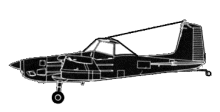
ASN Wikibase Occurrence # 190110
This information is added by users of ASN. Neither ASN nor the Flight Safety Foundation are responsible for the completeness or correctness of this information.
If you feel this information is incomplete or incorrect, you can submit corrected information.
| Date: | Friday 16 September 2016 |
| Time: | 09:15 |
| Type: |  Cessna A188 Agwagon 300 |
| Owner/operator: | Private |
| Registration: | N3547Q |
| MSN: | 188-0497 |
| Year of manufacture: | 1969 |
| Total airframe hrs: | 2741 hours |
| Engine model: | Continental IO-520D-9A |
| Fatalities: | Fatalities: 1 / Occupants: 1 |
| Aircraft damage: | Destroyed |
| Category: | Accident |
| Location: | Berrien County, NE of Alapaha, GA -
 United States of America United States of America
|
| Phase: | Manoeuvring (airshow, firefighting, ag.ops.) |
| Nature: | Agricultural |
| Departure airport: | Nashville, GA (4J2) |
| Nashville, GA (4J2) | |
| Investigating agency: | NTSB |
| Confidence Rating: |
The commercial pilot had completed one aerial application flight on the morning of the accident and planned to complete two additional flights. Using his trailer-based fuel tank, the pilot refueled the airplane to full, and his ground assistant added a mixture of chemicals and water to the airplane's hopper. The flight departed, and about 20 minutes later, two witnesses reported that they heard an airplane flying back and forth near their property until the engine noise went silent, which was followed by the sound of an impact. The accident site was in an open, plowed-dirt field that bordered the cotton field being sprayed.
Postaccident examination of the airframe and engine revealed no evidence of any preimpact mechanical malfunctions or failures. The damage to the wings, fuselage, and empennage were consistent with the airplane having been in a left spin at ground impact. Although dirt was found in the throttle-body metering unit filter, there was no dirt or other debris found upstream or downstream within the fuel system. Therefore, it is unlikely that the dirt affected engine operation, as it was most likely introduced during the impact. Further, the propeller separated from the engine and exhibited chord-wise scratching and s-bending, all of which were consistent with the engine producing power at the time of impact. Postaccident examination of the pilot's fuel source revealed no contamination, and although a small sample was discolored, the pilot was aware of the discoloration, and would pump fuel through the hose until the color returned to a normal 100LL color.
It is likely that the pilot proceeded from his base airport directly to the cotton field, which was the smaller of the two fields he intended on spraying during the accident flight. This was contrary to what the pilot normally did, which was to spray larger fields first to lighten the load before proceeding to smaller fields. The airplane's flight manual cautioned that the use of very low airspeeds in combination with heavy loads "reduces the margin of safety." It is likely that, while maneuvering at a low altitude over the smaller field with a heavy load, the pilot failed to maintain adequate airspeed, and the airplane exceeded its critical angle-of-attack and entered an aerodynamic stall and spin.
The cetirizine identified during toxicology testing was likely well below the lower therapeutic limit, and it is unlikely to have had any effects on the pilot at the time of the accident. The carbon monoxide identified during toxicology testing was most likely from the postimpact fire, and, as a result, did not contribute to the accident.
Probable Cause: The pilot's failure to maintain adequate airspeed while maneuvering at low altitude during aerial application operations, which resulted in the airplane exceeding its critical angle-of-attack and entering an aerodynamic stall and spin.
Accident investigation:
 |
|
Sources:
NTSB
FAA register: http://registry.faa.gov/aircraftinquiry/NNum_Results.aspx?NNumbertxt=3547Q
Location
Images:

Photo: NTSB
Revision history:
| Date/time | Contributor | Updates |
|---|---|---|
| 16-Sep-2016 17:07 | Geno | Added |
| 16-Sep-2016 18:23 | Geno | Updated [Time, Aircraft type, Registration, Cn, Operator, Source] |
| 17-Sep-2016 11:46 | Aerossurance | Updated [Operator] |
| 21-Jun-2018 20:00 | ASN Update Bot | Updated [Time, Operator, Departure airport, Destination airport, Source, Damage, Narrative] |
| 22-Jun-2018 06:13 | ASN Update Bot | Updated [Source] |
| 23-Jun-2018 09:37 | harro | Updated [Source, Narrative, Photo, ] |
Corrections or additions? ... Edit this accident description
The Aviation Safety Network is an exclusive service provided by:


 ©2024 Flight Safety Foundation
©2024 Flight Safety Foundation